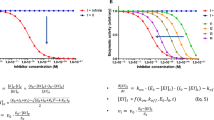Abstract
Unique sequence-binding sites are exposed on the surface of high molecular weight kininogen which complex prekallikrein or factor XI with high affinity and specificity. A sequence comprising 31 residues of the mature kininogen molecule (Asp565-Lys595) retains full binding activity for prekallikrein (KD=20 nM) and assumes a complex folded structure in solution which is stabilized by long-range interactions between N- and C-terminal residues. The sequence Trp569-Lys595 (27 residues) shows only 28% of this binding affinity and lacks the key structural features required for protein recognition (Scarsale, J. N., and Harris, R. B.,J. Prot. Chem.9, 647–659, 1990). We were thus able to predict that N- or C-terminal truncations of the binding-site sequence would disrupt the conformational integrity required for binding. Two new peptides of 20- and 22- residues have now been synthesized and their solution phase structures examined. These peptides are N- and C-terminal truncations, respectively, of the 27-residue sequence and correspond to the sequences Asp576-Lys595 and Trp569-Asp590 of high molecular weight kininogen. The results of fluorescence emission and circular dichroism (CD) spectroscopies in the range 25–90°C and from differential scanning calorimetry (DSC) all substantiate the idea that the C-terminal truncation peptide binds prekallikrein 35-fold poorer than the 31-residue peptide because it is relatively unoredered and possesses a less stable structure. Surprisingly, the N-terminal truncation peptide (20-mer) shows structural stability even at elevated temperatures and, like the 31-residue peptide, undergoes cold-induced denaturation observable in the DSC. 2D-NMR analysis of the 20-residue peptide revealed two distinct structures; one conformer possesses a more compact, folded structure than the other. However, the predicted structures assumed by either conformer are very different from those of either the 31- or 27-residue peptides. Hence, the binding affinity of the 20-residue peptide is 60-fold poorer than that for the 31-residue peptide because it assumes a nonproductive binding conformation(s).
Similar content being viewed by others
References
Bock, P. E., Shore, J. D., Tans, G., and Griffen, J. H. (1985).J. Biol. Chem. 260, 12,434–12,443.
Chang, C. T., Wu, C. C., and Yang, J. T. (1978).Anal. Biochem. 91, 13–31.
Freire, E., and Buktibebm, R. L. (1978).Biopolymers 17, 463–479.
Griko, Y. V., Privalov, P. L., Sturtevant, J. M., and Venyaminov, S. Y. (1988).Proc. Natl. Acad. Sci. USA 85, 3343–3347.
Page, J. D., and Coleman, R. W. (1989).Blood 74 (Suppl.), 291a (abstract).
Privalov, P. L. (1979).Adv. Prot. Chem. 33, 167–241.
Privalov, P. L. (1982).Adv. Prot. Chem. 35, 1–104.
Privalov, P. L., and Potekhin, S. A. (1986a). InMethods Enzymology. Hirs, C. H. W., and Timasheff, S. N. (eds.), Academic Press, New York, Vol. 131, pp. 4–51.
Privalov, P. L., Griko, Y. V., Venyaminov, S. Y., and Kutyshenko, V. P. (1986b).J. Mol. Biol. 190, 487–498.
Scarsdale, J. N., and Harris, R. B. (1990).J. Prot. Chem. 9, 647–659.
Tait, J. F., and Fujikawa, K. (1987).J. Biol. Chem. 262, 11,651–11,656.
Thompson, R. E., Mandle, R., and Kaplan, A. P. (1979).Proc. Natl. Acad. Sci. USA 76, 4862–4866.
Vogel, R., Kaufmann, J., Chung, D. W., Kellermann, J., and Müller-Esterl, W. (1990).J. Biol. Chem. 265, 12,494–12,502.
Wüthrich, K. (1986). InNMR of Proteins and Nucleic Acids, John Wiley and Sons, New York, pp. 1–286.
Author information
Authors and Affiliations
Rights and permissions
About this article
Cite this article
You, Jl., Scarsdale, J.N. & Harris, R.B. Calorimetric and spectroscopic examination of the solution phase structures of prekallikrein binding domain peptides of high molecular weight kininogen. J Protein Chem 10, 301–311 (1991). https://doi.org/10.1007/BF01025629
Received:
Published:
Issue Date:
DOI: https://doi.org/10.1007/BF01025629




